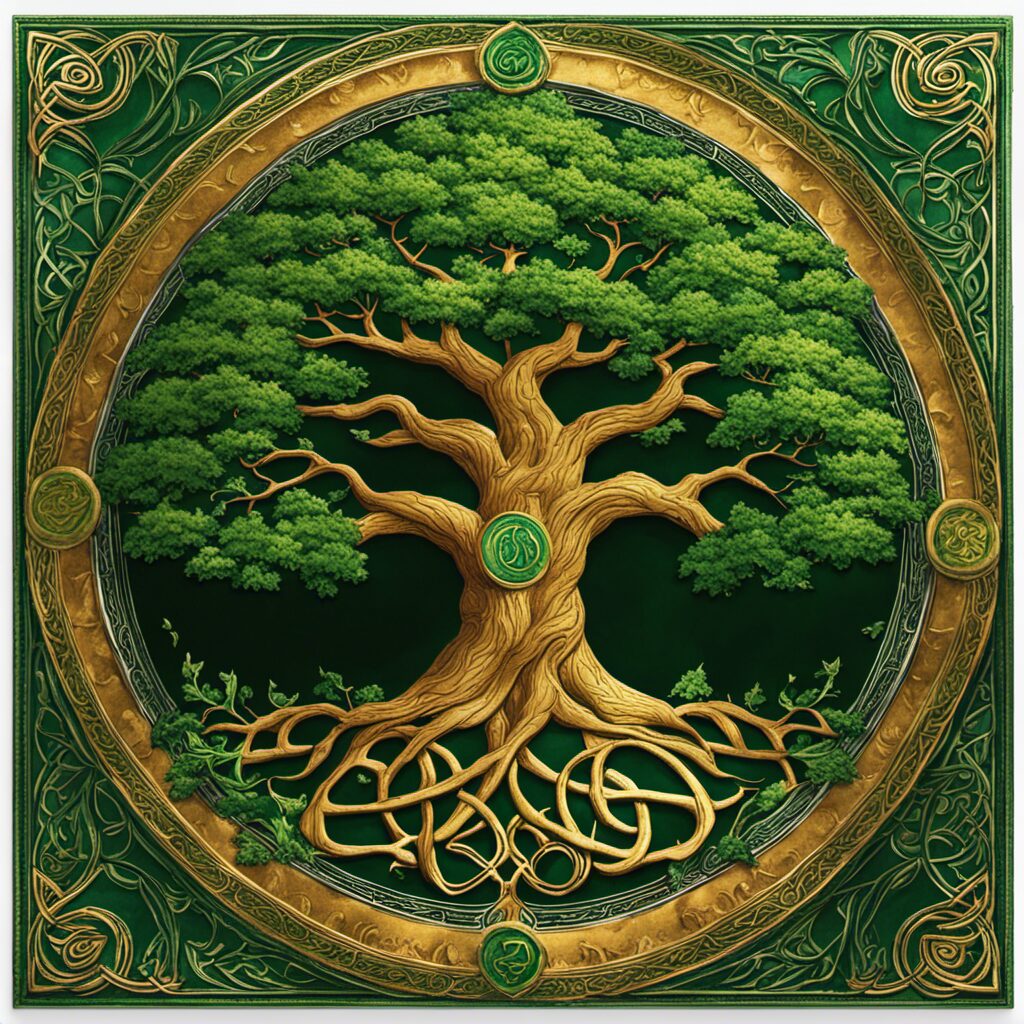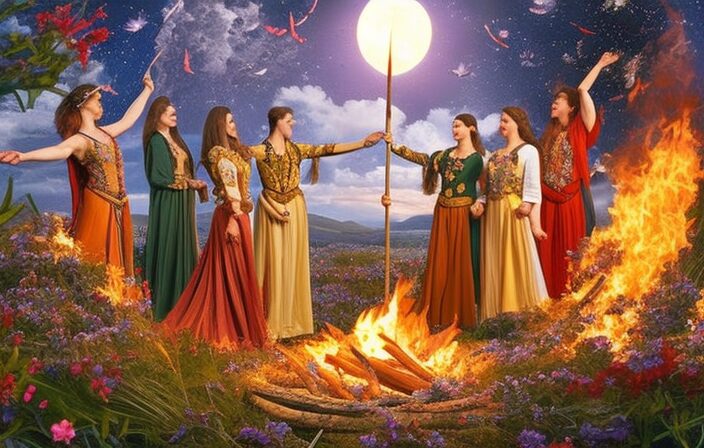The intricate and mysterious world of the Celtic calendar has long fascinated scholars, historians, and enthusiasts alike. Its ancient origins and complex system of timekeeping offer a unique lens through which to explore the rich cultural heritage of the Celts.
This article aims to decode the enigmatic symbols and meanings embedded within the Celtic calendar, shedding light on its historical significance, lunar cycle, key festivals, and connection to nature. Furthermore, it will delve into modern interpretations and adaptations of this ancient calendar system, providing a comprehensive understanding for those seeking to demystify its complexities.
Key Takeaways
- The Celtic calendar had a significant cultural and religious importance in ancient Celtic societies, marking important moments in the annual cycle and playing a crucial role in religious rituals and festivals.
- The Celtic calendar was based on lunar cycles and incorporated celestial observations, particularly the movements of the sun and moon, for more accurate time measurement.
- Moon phases and festivals were important elements in the Celtic calendar, with specific cultural practices and traditions aligned with different moon phases or celestial events.
- The Celtic calendar also had agricultural significance, with specific tasks and activities aligned with specific phases of the moon for optimized yields and sustainable agriculture.
History of the Celtic Calendar
The history of the Celtic calendar includes the development, evolution, and cultural significance of this timekeeping system within Celtic societies. The origins of the Celtic calendar can be traced back to ancient Celtic timekeeping practices. These early methods were primarily based on celestial observations, particularly the movements of the sun and moon. Ancient Celts divided their year into different seasons and lunar cycles, which were essential for agricultural activities and religious ceremonies.
As Celtic society evolved, so did their calendar system. In addition to lunar cycles, they also incorporated solar alignments and astronomical events into their timekeeping practices. This integration allowed for a more accurate measurement of time, enabling them to plan their agricultural activities in accordance with natural phenomena.
The Celtic calendar was not only a practical tool but also held significant cultural importance. It played a crucial role in religious rituals and festivals that marked important moments in the annual cycle. These festivities celebrated harvests, solstices, equinoxes, and other celestial events.
Although there is limited written evidence regarding the specifics of the ancient Celt’s calendar system due to its oral nature, archaeological findings such as megalithic structures aligned with astronomical events provide valuable insight into their understanding and use of time.
Overall, the history of the Celtic calendar showcases its deep connection to ancient Celtic culture and its vital role in both practical and spiritual aspects of life.
The Lunar Cycle in Celtic Calendars
Moon phases and festivals have significant importance in the context of lunar calendars.
The observation and understanding of moon phases allowed ancient cultures to track time and determine important events such as planting, harvesting, and religious ceremonies.
Additionally, lunar calendars played a crucial role in various cultural practices and traditions, with festivals often aligning with specific moon phases or celestial events.
Understanding the significance of moon phases and festivals within lunar calendars provides valuable insights into the cultural, social, and religious aspects of ancient civilizations.
Moon Phases and Festivals
Interpretation of Celtic calendars involves the analysis of lunar phases and their connection to various festivals. Moon phases played a crucial role in the Celtic calendar, as they determined the timing of important events and festivities.
The Celts observed the lunar cycle, which consisted of 29.5 days, to track the passage of time. They assigned specific meanings and significance to each phase of the moon, believing that it influenced various aspects of life such as fertility, abundance, and spiritual energy.
These lunar festivals were celebrated at different times throughout the year and were closely aligned with agricultural activities and seasonal changes. By understanding the connection between moon phases and festivals in Celtic calendars, we gain insight into the cultural practices and beliefs of ancient Celtic societies.
Lunar Calendar Significance
Lunar calendar systems provide a structured framework for tracking time and organizing events based on the lunar cycles. These calendars have been used by various cultures throughout history, including the ancient Celts.
The benefits of using a lunar calendar are numerous, particularly in relation to farming practices. The lunar cycle plays a crucial role in agricultural activities as it affects plant growth and development. By aligning planting, harvesting, and other agricultural tasks with specific phases of the moon, farmers can optimize their yields and improve overall productivity.
For example, planting during the waxing phase is believed to promote stronger root development, while harvesting during the waning phase is thought to enhance storage capabilities of crops. This deep understanding of the lunar cycle’s impact on farming allows for more efficient resource management and sustainable agricultural practices.
Key Festivals and Celebrations in the Celtic Calendar
The key festivals and celebrations in the Celtic calendar hold significant cultural and religious importance for the Celtic community. These festivals are deeply rooted in Celtic mythology, folklore, and traditions.
One of the most important festivals is Samhain, which marks the end of the harvest season and the beginning of winter. It is believed that during this time, the veil between the mortal world and the spirit world is at its thinnest, allowing spirits to roam freely among humans.
Beltane is another significant festival celebrated on May 1st, symbolizing fertility and new beginnings. It involves lighting bonfires to honor Belenus, the god associated with fire and sun.
Imbolc is a festival celebrated on February 1st marking the arrival of spring. It is dedicated to Brigid, a goddess associated with healing, poetry, and childbirth.
Lughnasadh or Lammas is observed on August 1st to celebrate the first harvest of grains such as wheat and barley. This festival was named after Lugh, a prominent god in Celtic mythology known for his skills as a warrior.
These key festivals not only provide an opportunity for individuals within the Celtic community to connect with their heritage but also serve as important cultural markers that reinforce their identity and sense of belonging. They offer a glimpse into ancient beliefs and practices while fostering a communal spirit among those who participate in these celebrations.
The Role of Nature in Celtic Calendars
Nature plays a significant role in the understanding and observance of festivals and celebrations within the Celtic calendar. The Celtic calendar is intrinsically connected to the natural world, with its cycles and rhythms dictating the timing and nature of these events. The importance of seasons and agricultural significance are central to this relationship.
The role of seasons in the Celtic calendar is crucial in determining when certain festivals take place. For example, Beltane, celebrated on May 1st, marks the beginning of summer and the return of fertility to the land. This festival is closely tied to agriculture, as it signifies the start of planting crops for a fruitful harvest later in the year.
Similarly, Samhain, celebrated on October 31st, marks the end of harvest season and transition into winter. It is a time when nature starts preparing for hibernation and death. Observing this festival allows Celts to acknowledge their dependence on nature’s cycles and honor those who have passed away.
Overall, by aligning festivals with seasonal changes and agricultural practices, Celts recognize their deep connection with nature. These celebrations serve as reminders that their lives are intricately intertwined with natural processes and provide opportunities for communal gatherings that strengthen social bonds within Celtic communities.
Deciphering the Symbols and Meanings of the Celtic Calendar
Symbols and meanings associated with the Celtic calendar can be explored to gain insight into its cultural significance and the beliefs of ancient Celtic communities. The Celtic calendar is rich in symbolism, with each month and season represented by specific symbols that reflect the natural world and the spiritual beliefs of the Celts. By deciphering these symbols, we can better understand how ancient Celts viewed time, nature, and their place within the cosmos.
-
Tree Symbols: Trees held great importance in Celtic culture, representing strength, wisdom, and connection to the divine. Each month was linked to a specific tree symbol, such as oak for June or yew for September. These symbols not only represented a particular time of year but also carried deeper meanings associated with growth, renewal, and spiritual transformation.
-
Animal Symbols: Animals played a significant role in Celtic mythology and were often associated with specific months or seasons in the calendar. For example, the stag symbolized fertility and abundance during autumn while the salmon represented wisdom and knowledge during springtime. These animal symbols served as reminders of the interconnectedness between humans and nature.
-
Celestial Symbols: The movement of celestial bodies was closely observed by ancient Celts as they believed it influenced various aspects of life on Earth. Lunar phases were particularly important in determining auspicious times for rituals or agricultural activities. Additionally, certain constellations held symbolic meaning within different months or seasons.
Understanding the Celtic Zodiac
One approach to gaining insight into the ancient Celtic zodiac involves examining the relationship between celestial bodies and their symbolic significance within different months or seasons. The Celtic zodiac is a system of astrology that originated in ancient Ireland and was based on the lunar calendar. Each month in the Celtic zodiac is associated with a specific tree, animal, and symbol. These symbols are believed to represent certain personality traits and characteristics.
The Celtic zodiac symbols include trees such as birch, rowan, ash, oak, holly, hazel, vine, ivy, reed, elder, fir, and yew. Each tree has its own unique qualities and attributes that are said to influence individuals born during that particular month. Similarly, animals like the stag, cat, snake, fox, bull, seahorse, wren, horse (or unicorn), salmon (or fish), swan (or butterfly), wolf (or dog), hawk (or falcon) correspond to different months in the Celtic zodiac.
Compatibility within the Celtic zodiac can be determined by examining the compatibility between these symbols. For example, trees that share similar qualities may have a higher level of compatibility. Additionally, animals that possess complementary attributes may also indicate potential compatibility between individuals.
Understanding the symbolic significance of celestial bodies and their association with different months or seasons provides valuable insights into the ancient Celtic zodiac system. By exploring these connections through detailed analysis and scholarly research methods we can gain a deeper understanding of this fascinating astrological tradition.
Modern Interpretations and Adaptations of the Celtic Calendar
This discussion delves into the contemporary Celtic calendar and explores its modern interpretations and adaptations.
The contemporary Celtic calendar has evolved over time, with various interpretations emerging in recent years.
These adaptations raise questions about their cultural relevance and how they connect to ancient Celtic traditions.
Contemporary Celtic Calendar
The contemporary Celtic calendar is a system used by modern-day practitioners to mark significant dates and observe seasonal changes in alignment with ancient Celtic traditions. This adaptation of the traditional calendar has gained popularity among individuals interested in Celtic culture and spirituality.
The cultural significance of the contemporary Celtic calendar lies in its ability to connect practitioners with their ancestral heritage, providing a framework for celebrating important events such as solstices, equinoxes, and cross-quarter days. It serves as a reminder of the cyclical nature of life and the interconnectedness between humans and nature.
Additionally, this calendar fosters a sense of community among individuals who follow these practices, as they come together to honor shared beliefs and traditions. The contemporary Celtic calendar thus plays a crucial role in preserving and revitalizing Celtic culture in modern times.
Cultural Relevance of Adaptations?
The contemporary Celtic calendar has undergone various cultural adaptations over the years, resulting in its continued relevance and influence on modern cultural traditions.
These adaptations reflect the dynamic nature of Celtic culture and its ability to adapt to changing societal needs and beliefs.
One example of cultural adaptation is the incorporation of Christian festivals into the Celtic calendar, such as Easter and Christmas, which were integrated with pre-existing pagan celebrations.
This blending of religious practices allowed for the preservation of ancient Celtic customs while simultaneously accommodating new belief systems.
Additionally, modern interpretations of the Celtic calendar have expanded beyond its original function as a timekeeping system to include elements like astrology, spirituality, and personal growth.
These adaptations demonstrate how the Celtic calendar continues to shape and inspire contemporary cultural practices today.
Conclusion
In conclusion, the Celtic Calendar holds a rich history and significance in the Celtic culture. Its lunar cycle and connection to nature played a crucial role in guiding the lives of ancient Celts. The symbols and meanings within the calendar provided a deeper understanding of their world.
Furthermore, modern interpretations and adaptations have allowed this ancient system to persist in contemporary society. Interestingly, it is estimated that there are over 400 different variations of the Celtic Calendar, showcasing its complexity and diversity across different regions.




